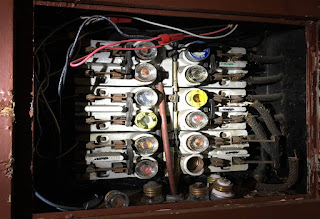Fused Neutrals: How to Spot Them; Why They Are Dangerous

Fused neutrals were used primarily in the 1920’s. At that time electricians thought that having protection on both the hot and neutral sides would provide “double” protection for a circuit. This actually proved to be just the opposite and very dangerous. A single fuse provides protection for neutral to phase and phase to ground faults. A fuse on the neutral conductor provides protection for neutral to phase faults only. If there is a short (to ground), the current will bypass the neutral and not blow the fuse. Also if the circuit is overloaded, one fuse will blow before the other. If the neutral fuse blows, the circuit will in fact be interrupted, however power will still be flowing from the hot side. Even though the circuit will appear to be “dead”, (no light or power to the receptacle), there is actually power through the circuit to the blown fuse on the neutral side. This may cause electrocution. Fused neutrals are part of a open Edison fused outdated service panel. Most home inspectors recommend that a fused electric service panel is updated with a circuit breaker panel. I have heard some electricians say that they prefer fused service panels. I understand why they say that. I inspected a house with a properly wired modern fused main service panel. The homeowner was an older master electrician, who told me he would never use circuit breakers. We know that fuses, if sized and installed properly cannot malfunction. However, fused neutrals, even if properly sized and connected, are dangerous by design and must be upgraded. As always, we would recommend a licensed electrician perform the upgrade.
Related Articles:
- GFCI Inspections
- Inspecting Exterior Electrical Components
- Counterfeit Square D Circuit Breakers
- Electrical Sub-Panels – Why Must the Neutrals & Grounds Be Separated
Want To Learn More? Click HERE to Search Our Full Database Of Home Inspector Newsletters.



